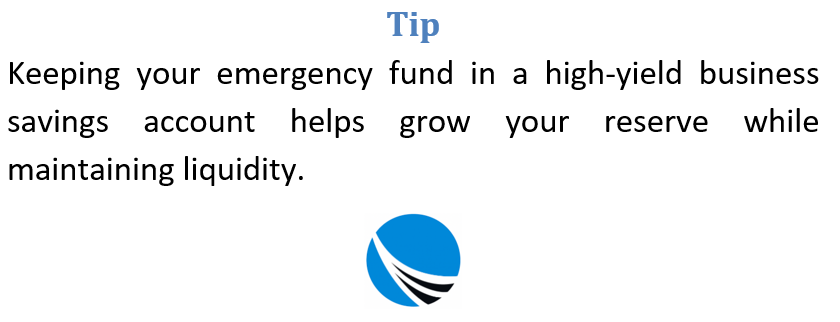Unforeseen crises can threaten a business’s survival without warning. From natural disasters to sudden loss of income, businesses often face emergencies that require quick financial responses. This is where an emergency reserve fund becomes invaluable. A dedicated financial cushion not only provides immediate relief during difficult times but also strengthens your long-term resilience.
This article outlines a comprehensive strategy to help you create, manage, and protect an emergency financial reserve that supports your business in times of disruption.

Understanding What a Business Emergency Fund Is
A business emergency fund is a dedicated pool of cash that a company sets aside to respond to sudden financial disruptions. Unlike personal savings, this fund is strictly meant for business use—covering critical expenses like rent, payroll, utilities, repairs, or temporary operational shortfalls.
This fund plays a vital role during periods when revenue streams dry up or expenses spike unexpectedly. Whether your business experiences supply chain breakdowns, security breaches, or economic slowdowns, having access to emergency capital can prevent hasty decisions like layoffs or service shutdowns.
The size of this fund varies depending on the nature of the business, but a general benchmark is to save at least three to six months’ worth of operating expenses. For businesses in risk-prone industries or highly seasonal sectors, a more robust reserve may be necessary.
Why You Need an Emergency Fund Separate from Personal Reserves
It’s important to draw a clear line between your personal emergency savings and your business’s financial reserves. While personal funds might support you during a personal financial crunch, they should not be relied upon to save your company during a business emergency.
A business-specific reserve fund ensures that professional responsibilities, such as paying employees or continuing customer service, are met even when revenue is disrupted. This separation protects both your personal and professional financial health, and adds credibility when seeking future investments or loans.

Steps to Determine the Right Fund Size for Your Business
Before you can start saving, it’s crucial to calculate how much your emergency fund should hold. Begin by reviewing your monthly fixed and variable costs. Fixed costs may include rent, insurance, and salaries, while variable costs involve inventory, marketing, or utilities.
Once you have an average monthly figure, multiply it by the number of months you want the fund to cover. For instance, if your business spends $15,000 monthly and you aim to save for six months, your goal should be $90,000.
Keep in mind that your business’s exposure to risk, industry volatility, and seasonal income fluctuations should guide whether your reserve should lean toward the lower or higher end of that spectrum.
Creating a Saving Plan That Won’t Disrupt Operations
Funding a reserve account doesn’t have to strain your daily operations. Start by reviewing your cash flow and identifying surplus or unallocated revenue. Consider contributing a fixed percentage of your monthly profit or setting aside occasional windfalls, such as tax refunds or rebates.
Automating transfers to your emergency fund through your bank can ensure consistency and discipline. Even modest monthly contributions can accumulate significantly over time.
Businesses that experience inconsistent income cycles can adapt this approach by saving more in high-income months and less during slow periods, maintaining a steady overall trajectory toward their savings goal.
Where to Store Emergency Funds for Safety and Accessibility
The type of account you choose for your emergency reserves can impact both the growth and accessibility of your savings. Opt for accounts that combine liquidity with reasonable returns, such as high-yield business savings accounts or business money market accounts.
For funds that won’t need to be accessed immediately, Certificates of Deposit (CDs) with staggered maturity dates can offer higher interest earnings while still ensuring periodic access.
The key is to avoid locking away all your reserve capital in instruments that charge early withdrawal penalties or are difficult to liquidate quickly. Strike a balance between safety, liquidity, and earning potential.
Setting Boundaries for Emergency Fund Usage
To ensure your reserve fund is used appropriately, establish clear guidelines on what constitutes a valid emergency. These could include:
- Equipment breakdowns halting production
- Disruption in a key revenue stream
- Physical damage to your premises
- Legal liabilities requiring immediate settlement
Designate authorized individuals who can access the funds, and under which conditions they may do so. These protocols can be documented within your business continuity or crisis management plan to ensure alignment and consistency.
Educating Your Team on Emergency Fund Protocols
An emergency fund is most effective when your team understands its role and restrictions. Key stakeholders—such as financial officers, department heads, or managers—should be briefed on when and how the fund can be tapped.
This transparency prevents confusion during emergencies and protects against misuse. Written procedures should be circulated and incorporated into your financial governance policies. Making these policies a part of onboarding or regular team updates also reinforces their importance.
When It’s Time to Use the Reserve—and When It Isn’t
Not all financial dips justify using your reserve fund. It should be treated as a last resort, meant for critical and time-sensitive disruptions. If the situation can be managed using current revenues, adjusting budgets, or accessing credit, those avenues should be explored first.
Use the fund when operations are at risk of ceasing or when revenue drops so sharply that it endangers business continuity. Common valid triggers include:
- A severe drop in customer demand due to external events
- A prolonged power outage or disaster shutting down operations
- The need for emergency repairs not covered by insurance
Always assess the potential for recovery support—like insurance claims or government aid—before draining the reserve. Consider whether partial use is sufficient to stabilize the business without exhausting the entire reserve.
Rebuilding the Emergency Fund After It’s Used
Once you’ve tapped into your reserve, rebuilding it should become a top financial priority. Start by reassessing your business cash flow to determine how soon you can resume contributions.
If necessary, shift non-essential expenses to gradually funnel more resources toward the fund. As revenue normalizes, resume monthly contributions or temporarily increase the percentage of profits allocated to rebuilding the reserve.
Document lessons learned from the emergency, including how the fund was used, and whether your original reserve goal was sufficient. Use that insight to refine your fund size and savings strategy moving forward.
Periodically Review and Adjust the Fund
As your business evolves, so do your financial needs. Conduct annual reviews of your emergency reserve alongside budget planning to ensure it still aligns with your current risk profile.
For instance, if you’ve added a second location, expanded your workforce, or entered a new market, your emergency costs may rise. Conversely, if you’ve streamlined operations or reduced overhead, you may be able to revise your target downward.
Keep your emergency fund strategy flexible. Regular reassessment allows you to respond to changing circumstances and helps keep the reserve a strong line of defense.
Supplementing Emergency Reserves with Insurance
While a cash reserve is a powerful safeguard, it should be part of a broader financial protection strategy. Comprehensive business insurance—covering property damage, liability, cyber threats, and income loss—can ease the pressure on your emergency fund.
By integrating both financial reserves and insurance, you ensure a more comprehensive defense against disruptions. Insurance can absorb the longer-term costs of a crisis, while your reserve handles the immediate shortfalls.
Ensure your policies are up to date and aligned with your operations, and revisit them annually to fill in any new gaps in coverage.
Takeaway
Building and maintaining a business emergency reserve is a proactive way to protect your livelihood. Whether you’re navigating the fallout from a sudden crisis or simply want to safeguard against future uncertainties, this financial cushion gives you space to make thoughtful decisions rather than reactive ones.
Establish clear rules, automate contributions, reassess regularly, and educate your team. When combined with good insurance and sound financial management, your emergency reserve fund becomes an essential part of your company’s foundation for growth and longevity.
In uncertain times, resilience is built not only on agility but on preparedness. A well-funded emergency reserve allows you to face challenges head-on, ensuring your business remains strong, stable, and focused on the future.

Important Questions on Emergency Financial Reserves
What Is a Business Emergency Fund and Why Is It Important?
A business emergency fund is a reserved pool of cash meant to cover unexpected disruptions such as equipment failure, revenue loss, or natural disasters. It provides financial stability during crises and helps maintain core operations like payroll and rent.
How Much Should a Business Save in Emergency Reserves?
Aim to save at least three to six months’ worth of operating expenses. The exact amount depends on your business’s size, industry volatility, and risk exposure.
Where Should Emergency Funds Be Stored?
Use high-yield business savings accounts, money market accounts, or Certificates of Deposit for accessibility and interest growth while maintaining fund security.
When Should a Business Use Its Emergency Fund?
Use it during critical, unexpected events that threaten business continuity—such as sudden loss of a major client, a natural disaster, or major operational disruptions.
How Can a Business Replenish Its Emergency Fund After Use?
Rebuild the fund gradually by adjusting expenses, contributing from monthly profits, and prioritizing replenishment in the business’s financial plan.

